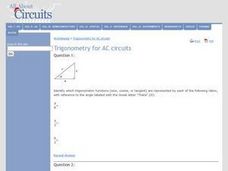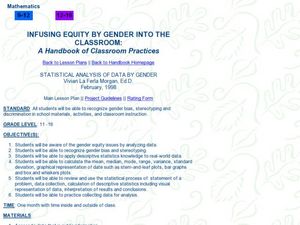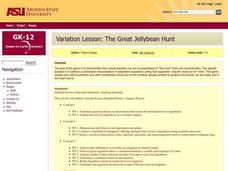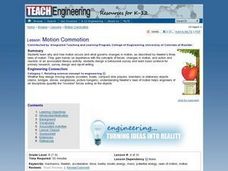Curated OER
Trigonometry for AC Circuits
In this physics worksheet, students solve 23 trigonometry based problems. Students apply the Pythagorean Theorem in electricity calculations.
Curated OER
Infusing Equity Gender into the Classroom
Students investigate if gender makes a difference in the classroom. In this statistics lesson, students collect data on whether equity by gender in the classroom makes students more successful.
Curated OER
Exploring Real Numbers
In this algebra activity, 11th graders classify numbers as rational, irrational, integral and whole. They solve the equations and graph i ton a number line. There are 26 questions with an answer key.
Curated OER
Quadratic Equations and Parabolas
Learners graph and solve quadratic equations. In this functions lesson plan, students analyze a quadratic equation using three points on a curve to define the graph of a quadratic function. They find the vertex and intercepts of the graph.
Curated OER
What's the Best Deal?
Young scholars explore number sense by solving consumer math problems. In this pattern identification lesson, students analyze a list of numerical and geometric patterns while predicting the future outcome. Young scholars utilize...
Curated OER
Modeling the Big Bang and the Formation of the Universe
Sixth graders conduct an experiment to understand the Big Bang Theory. In this Big Bang Theory lesson, 6th graders will observe a balloon with confetti popping to emulate and analyze information related tot he Big Bang theory. Students...
Curated OER
DISCOUNT LENSES ( GELATIN WAVE GUIDES)
High schoolers study attributes associated with concept of fiber optics is done using a labmade fiber optic from clear molded gelatin. A variety of shapes can be cut and pieced together to form a conduit to transmit the laser beam by...
Curated OER
Giant Mystery
Third graders determine the relationship between hand size and body size using centimeters as the unit of measure, They use the relationship to find the size of a hypothetical giant. They graph the measurements using a spreadsheet program.
Curated OER
The Colors of Chemistry
Students investigate the acidity and alkalinity of common household products in an experiment. They use red cabbage juice and litmus paper to show the difference between strong acids and bases as they work with vinegar, dish washing...
Curated OER
Does that Sound Right to You?
Ninth graders are introduced to the components of compressional and transverse. They practice answering speed problems involving different mediums that waves travel trhough and then review the wave PowerPoint. They then visit physics...
Curated OER
Distribution of children living at home
Students use E-STAT to examine demographics. In this social demographics lesson, students use statistical data to determine if a particular family is in need of assistance. Students will discuss social and educational policies and...
Curated OER
Slums in the Spotlight: Will the Millennium Development Goals’ Target be Met?
Students examine the conditions of slums in the world. In this critical thinking skills instructional activity, students compare the places that people live in the world as they view scenes from the film "Slumdog Millionaire." Students...
Curated OER
Science: Wind Power
Students build models of wind turbines and experiment with different designs that will improve efficiency. Students will understand the use of wind power as a renewable resource.
Curated OER
Teaching about Data Interpretation
Students explore a variety of relevant lake water chemistry questions, compose responses, and present their results in a poster format. They, in pairs, answer questions about lake chemistry which are imbedded in this plan.
Curated OER
Mixing it up with Romeo and Juliet
Learners create a soundtrack for Romeo and Juliet choosing one song to represent each scene. They write a paragraph explaining their song choices.
Curated OER
Energy Eccentricity
Students assess their own energy use to help develop an awareness of the different types of natural resources affected by consumers. Their calculations show them how much they are personally impacting the Earth. Very meaningful and...
Curated OER
It's Clean, Fresh and only Three Billion Years Old - Water!
Students engage in a lesson plan which explores the wate cycle. They get to see some very entertaining video, do fun hands-on activities and gain a better understanding of evaporation, condensation, precipitation and collection.
Curated OER
EBT-rimental
Students engage in a instructional activity that gives them the tools needed to become knowledgeable credit consumers. The companion website for the ITV program TV-411 is used to provide learners with an interactive experience of what...
Curated OER
What Plants Need in Order to Survive and Grow: Soil
Students conduct an experiment to evaluate whether plants need soil to survive and grow. They plant two seeds, one with soil and one without, make predictions, and record and analyze the seed germination results on a worksheet.
Curated OER
The Great Jellybean Hunt
Students explore natural selection and its influence on the populations to fine tune traits and characteristics. The acquisition of traits developed out of need is examined through a game played in class.
Curated OER
Cookie Creations
Students, in teams, create and prepare an original cookie recipe. They market their cookie by designing creative packaging and advertising. They compete with other groups in a cookie contest.
Curated OER
Science: Motion Commotion
Learners examine Newton's three laws of motion to discover what causes it and how it changes. They conduct motion experiments by building catapults and constructing balloon rockets. Finally, they conduct peer studies correlating...
Curated OER
Are Colleges Still Affordable?
Students investigate mathematical model that compares cost of higher education to potential earnings in order to decide if the investment is a good one. They compute amount to be repaid each year for the life of a student loan and then...
Curated OER
Conceptualizing an Experiment
Students work together to design an experiment. They discover the origin of a family artifact. They analyze the data and discuss the results. They determine if the experiment is the best way to find out this type of information.

























